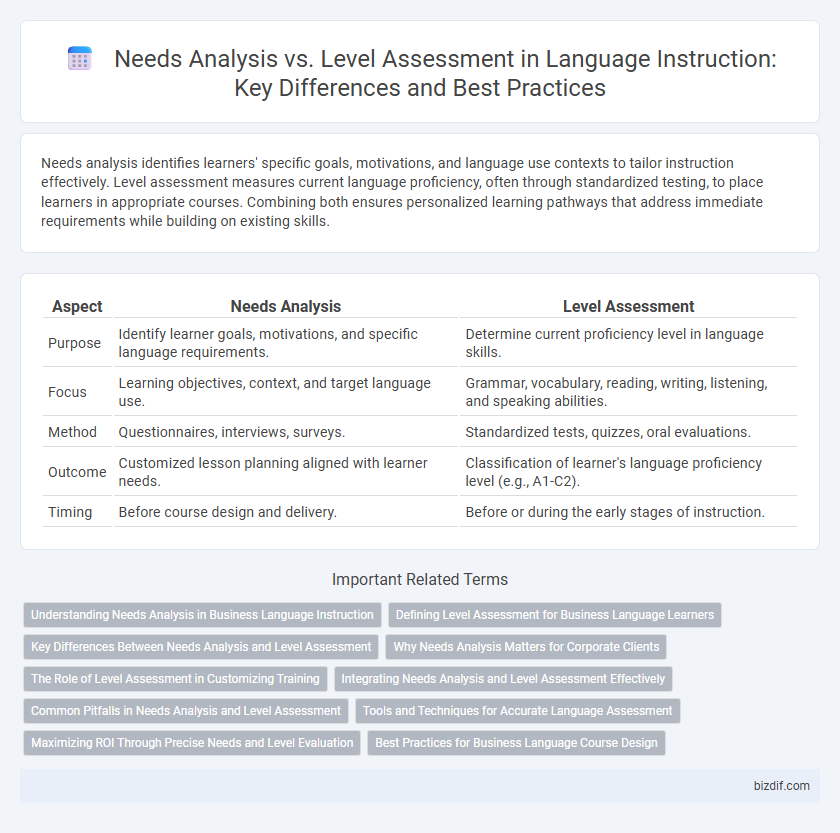Needs analysis identifies learners' specific goals, motivations, and language use contexts to tailor instruction effectively. Level assessment measures current language proficiency, often through standardized testing, to place learners in appropriate courses. Combining both ensures personalized learning pathways that address immediate requirements while building on existing skills.
Table of Comparison
| Aspect | Needs Analysis | Level Assessment |
|---|---|---|
| Purpose | Identify learner goals, motivations, and specific language requirements. | Determine current proficiency level in language skills. |
| Focus | Learning objectives, context, and target language use. | Grammar, vocabulary, reading, writing, listening, and speaking abilities. |
| Method | Questionnaires, interviews, surveys. | Standardized tests, quizzes, oral evaluations. |
| Outcome | Customized lesson planning aligned with learner needs. | Classification of learner's language proficiency level (e.g., A1-C2). |
| Timing | Before course design and delivery. | Before or during the early stages of instruction. |
Understanding Needs Analysis in Business Language Instruction
Needs analysis in business language instruction identifies specific communication goals, industry terminology, and workplace scenarios to tailor training effectively. It involves collecting data from interviews, surveys, and observation to understand learners' professional roles and language requirements. This process ensures that course content aligns with practical business demands, enhancing relevance and learner engagement.
Defining Level Assessment for Business Language Learners
Level assessment for business language learners measures proficiency through standardized tests and practical simulations to identify current capabilities in professional communication. It pinpoints strengths and weaknesses across listening, speaking, reading, and writing skills relevant to business contexts. This targeted evaluation informs tailored instruction to enhance workplace language effectiveness.
Key Differences Between Needs Analysis and Level Assessment
Needs analysis identifies learners' specific goals, preferences, and objectives to tailor instruction effectively, while level assessment measures current language proficiency to place students in appropriate courses. Needs analysis involves gathering qualitative data through interviews and questionnaires, whereas level assessment relies on standardized tests and performance metrics. The key difference lies in needs analysis guiding personalized content design, while level assessment focuses on benchmarking language skills.
Why Needs Analysis Matters for Corporate Clients
Needs analysis identifies specific language skills required for corporate roles, enabling tailored training programs that enhance employee performance. It uncovers gaps in communication relevant to industry tasks, ensuring learning objectives align with business goals. Level assessment alone measures proficiency but lacks insight into context-specific demands, making needs analysis essential for effective corporate language instruction.
The Role of Level Assessment in Customizing Training
Level assessment plays a critical role in customizing language training by accurately identifying learners' current proficiency across key language skills such as speaking, listening, reading, and writing. Precise evaluation of individual levels enables instructors to tailor course content, instructional methods, and pacing to match each learner's strengths and areas for improvement. This targeted approach maximizes learning efficiency and ensures that training outcomes align closely with both learner goals and language competency standards.
Integrating Needs Analysis and Level Assessment Effectively
Integrating needs analysis and level assessment effectively enhances language instruction by identifying learners' goals, motivations, and proficiency simultaneously. Combining diagnostic tests with personalized interviews provides a comprehensive understanding of learners' abilities and specific needs. This integrated approach enables tailored curriculum design that maximizes learning outcomes and resource allocation.
Common Pitfalls in Needs Analysis and Level Assessment
Common pitfalls in needs analysis include relying on generic questionnaires that fail to capture learners' specific goals, contexts, and learning preferences, leading to ineffective instruction design. Level assessment often suffers from inconsistent criteria and limited skill coverage, such as focusing solely on grammatical knowledge while neglecting communicative competence. Addressing these challenges requires integrating comprehensive, tailored tools that evaluate both language needs and proficiency for more accurate and actionable insights.
Tools and Techniques for Accurate Language Assessment
Needs analysis employs surveys, interviews, and observations to identify learners' goals and contextual language requirements, ensuring tailored instruction. Level assessment utilizes standardized tests and placement exams to measure proficiency across speaking, listening, reading, and writing skills, providing benchmark data for curriculum alignment. Combining qualitative tools like learner portfolios with quantitative methods such as computer-adaptive testing enhances the accuracy of language assessment outcomes.
Maximizing ROI Through Precise Needs and Level Evaluation
Maximizing ROI in language instruction depends on precise needs analysis and level assessment to tailor learning programs effectively. Needs analysis identifies specific learner objectives and contextual requirements, ensuring relevant content delivery, while level assessment gauges current proficiency for appropriate challenge calibration. Combining these evaluations optimizes resource allocation, accelerates skill acquisition, and enhances overall training impact.
Best Practices for Business Language Course Design
Needs analysis identifies specific communication goals and workplace contexts, ensuring tailored business language course content. Level assessment evaluates current language proficiency, enabling precise placement and appropriate skill development. Integrating both practices optimizes course relevance and learner engagement for effective business communication training.
Needs Analysis vs Level Assessment Infographic

 bizdif.com
bizdif.com